Abstract
Between August and October 2000, a cross-sectional study was conducted in smallholder dairy farms in Mbale District, Uganda to assess the prevalence of ticks and tick-borne diseases under different grazing systems and agro-ecological zones and understand the circumstances under which farmers operated. A questionnaire was administered to obtain information on dairy farm circumstances and practices. A total of 102 farms were visited and sera and ticks were collected from 478 animals. Sero-prevalence of tick-borne diseases was determined using an enzyme-linked immunoassay. Acaricides were used indiscriminately but the intensity of their use varied with the grazing system and zone. Cattle from different farms mixed for various reasons. During the dry seasons farmers have to get additional fodder from outside their farms that can result in importation of ticks. The prevalence of ticks and serum antibodies to tick-borne infections differed across the grazing systems and zones. The highest serum antibody prevalence (>60%) was recorded in the lowland zone under the free range and tethering grazing systems. The lowest tick challenge and serum antibody levels (<50%) were recorded in the midland and upland zones under a zero-grazing system. These findings suggest that endemic stability to East Coast Fever, babesiosis and anaplasmosis is most likely to have existed in the lowland zone, particularly, under the tethering and free-range grazing systems. Also, endemic stability for babesiosis existed in the upland zones. Endemic instability for East Coast Fever existed in the midland and upland zones. These structured observational studies are instrumental in planning of control strategies for ticks and tick borne diseases since production systems and the cattle population at high risk of the diseases in the district have been identified.
| Abbreviation: | |
|---|---|
| zone | agro-ecological zone |
Keywords: Livestock, systems, epidemiological state, Theileria parva, Theileria mutans, Babesia bigemina, Anaplasma marginale
Introduction
Mbale District is located in the eastern region of Uganda bordering with the Republic of Kenya in the east. The district covers a total land area of 2,504 square kilometers and lies approximately between latitude 0° 45′ N; and 0°35′ N and longitudes 34° and 34°, 35′ E. The district is made of five counties of Bungokho, Bubulo, Manjiya, Budadiri and Bulamburi. The district has diverse climatic and environmental conditions due to variation in altitude, rainfall and agricultural activities. The topography of the district can be conveniently divided into three distinct types: (1) Lowland at an altitude of 1100–1350 m above sea level. This merges into extensive undulating plateau but is occasionally interrupted by a few upland and mountain ridge extensions. (2) The upland, which starts from the upper levels of Mbale plain, rises to form a hill and valley topography. The altitude is about 1800m above sea level. (3) The Elgon mountain with its highest point 4,322m above sea level. The orographic effect of Mountain Elgon massif and the district's proximity to Lake Victoria increase the amount of rainfall and tamper the severity of the dry periods. The distribution of this rainfall is irregular and depends on the location. Accordingly, three agro-ecological zones (zones) are identified. These are the lowland zone, the midland zone and the upland zone; the three falling in the lowland and upland typographical types.
The district is densely populated and so there is a general shortage of land for agriculture. This land shortage problem is compounded by the hilly landscape, which makes some parts inhabitable. The majority of the farmers, therefore, are small holder farmers living in scattered homesteads where they keep limited number of cattle under zero-grazing, tethering, fenced and free-range grazing systems depending on land availability and the zone. In the midland and upland zones (Budadiri, Bulamburi and Manjiya counties) perennial crops (banana and coffee) are grown while in the lowland zone (Bubulo, Bungokho and lower parts of Bulamburi counties) annual crops (maize and beans) are grown.
The district enjoys a favourable climate for agriculture and plant growth. This climate, however, also provides ideal conditions for ticks, the vectors of tick-borne diseases, namely Rhipicephalus appendiculatus for East Coast Fever (ECF), Boophilus decoloratus for babesiosis and anaplasmosis and Amblyomma variegatum for heartwater (Branagan, 1973). As a result cattle in the district are under constant threat of severe tick infestations and tick-borne diseases unless tick control measures are undertaken (Maywald 1987, Perry 1994).
Tick-borne infections are known to exert the greatest limitations for improved cattle production by causing serious debility, morbidity, mortality and production losses in susceptible exotic cattle, hybrids, as well as in indigenous breeds of cattle raised in tick-borne disease free areas (Bram 1982, Yeoman 1966, Norval et al. 1992, Okello-Onen et al. 1994, Perry and Randolph 1999). Generally the occurrence and importance of tick-borne diseases is a reflection of complex interactions involving the causative organisms, the tick vectors, the vertebrate hosts and the environment (Norval et al. 1992). These interactions are driven and modified by a wide variety of factors ranging from climate, soil and vegetation to human activities including crop/livestock production systems and measures taken to control ticks and tick-borne diseases.
Control of tick-borne diseases in East Africa has proved difficult largely because of lack of epidemiological information (Norval et al. 1992) and because control strategies commonly applied are not integrated in the production system (Perry 1994). In most parts of Africa, earlier investigations were not location/production system-specific and did not target biological, management and social economic parameters of the production system to establish the presence and magnitude of the problems due to tick-borne diseases (Pegram and Chizyka 1987; Amir and Knipscheer 1989). As a result, in most cases control efforts have not been commensurate to the magnitude of the disease problem. In Uganda the influence of the different management systems, the disease control practices and the changing patterns of land use on the epidemiological status of the tick-borne diseases are not well understood. In the Kenya highlands (Deem et al. 1993; Gitau et al. 1994; Gitau et al. 1997; O'Callaghan 1998; Perry and Young, 1990; Gitau et al. 2000) have demonstrated that the prevalence of Theileria parva infections and the reported East Coast Fever morbidity, mortality and case-fatality can vary significantly by zones and grazing system and that these differences have important implications for both the impact and control of East Coast Fever.
The impetus to carry out this study in Mbale District came out of a diagnostic survey using participatory rural appraisal methodologies (NARO/LSRP report, 1999) that ranked tick-borne diseases and helminthosis as the most important constraints to dairy production. Formulation of appropriate control strategies was deemed the solution.
This study was, therefore, production system-specific with the objective of assessing the prevalence of ticks and serum antibodies to tick-borne infections and the farmer circumstances and practices in Mbale District by zone, grazing system and age of the animals. The purpose was to characterize the potential risks and associated epidemiological states. This would help identify potential endemically stable and unstable areas. Existence of endemic stability in the district would imply that control could be selective, strategic and focused only on susceptible target cattle populations. This would reduce costs and environmental pollution associated with intensive acaricide use.
Materials and methods
Study design
The farms were selected by a stratified random sampling method. The strata were zones, grazing system and age of the animals. A sampling frame of the parishes (the smallest administrative units) and villages in each subcounty was obtained from the District Veterinary Office, Mbale. The parishes were classified according to the three zones, and 6 parishes in each zone were selected using random numbers. The antibody prevalence was not known a priori and so a 50% prevalence and a 20% tolerable error were assumed when determining the number of farms to include in the study. The sample size was determined according to the method described by Martin et al. (1987). The number of required farms per zone was calculated to be 25. Since farm-to-farm variation was expected in some cases (although average serum antibody prevalence by parish was expected to be constant within a zone), it was necessary to inflate the sample size by 40%. This gave 35 farms in the 6 parishes of each zone. For each zone, it was determined a priori to select 8 farms from the fenced grazing system and 9 farms from each of the remaining grazing systems (zero-grazing, tethering and free range). The veterinarians in charge of the selected parishes were then asked to compile a sampling frame of the farms in each of the 4 grazing systems in the selected parishes. The required number of farms in each grazing system was selected using tables of random numbers. However, of the 105 farms selected for study, three farmers declined to participate. Except in a few cases (where there were many animals on a farm), all animals in the age groups 0–3, 4–12, 13–18 and >18 months, were sampled. Where the number of animals in an age group exceeded 10, systematic random sampling was applied to select at least 5 animals. A total of 478 animals were examined and sampled.
Data and sample collection
Ten milliliters of blood were collected from each animal in vacutainer tubes by jugular venipuncture. Two to three milliliters of this blood was transferred to small vials coated with EDTA from which thin and thick blood smears were made and stained with Giemsa to determine if it was infected with hemoparasites. Part of this blood was collected in capillary tubes to determine the packed cell volume, using the hematocrit centrifugation technique. The rest of the blood in the vacutainer tubes was stored in iceboxes while in the field and later refrigerated overnight in the laboratory. Serum samples were separated the following day and were stored at (−20°C). Antibodies against tick-borne parasites were detected in sera using an enzyme-linked immunoassay technique (Katende et al. 1998). The results were expressed as percent positivity (PP) according to Wright et al. (1993), simply expressed as:
PP = (optic density of test serum/optic density of strong positive) ×100
For Theileria parva and T. mutans, a sample was considered positive if the percent positivity value was 20 or above; for Babesia bigemina and Anaplasma marginale, the cut-off PP value was 15, while for B. bovis the cut-off point was 30.
Whenever swollen parotid and/or prescapular lymph nodes were palpated, lymph node biopsy smears were made and stained with Giemsa to detect Theileria schizonts under microscopy. This provided information on the morbidity of East Coast Fever.
Ticks were counted from one side of the animal body. The tick species; their sex and the state of feeding of female ticks were also determined (Kaiser et al. 1982). At each farm, a structured questionnaire with close-ended questions was administered to the farmer or farm manager to capture information on farm circumstances (management practices; farmer's needs/problems or challenges; coping strategies and opportunities; gender roles and criteria for choosing disease control technologies).
Data storage and analysis
Data derived from questionnaires and laboratory examinations were stored in Microsoft Excel. In order to eliminate the interference of maternal antibodies in sera of calves (0 – 3 months old), sera from older calves aged 4 – 12, were used to detect sero-conversion and to assess the epidemiological states of tick-borne diseases. Animals were classified as positive or negative depending on whether they were above or below the PP cut-off point. Univariate associations between explanatory variables (e.g., zone and grazing system) and the outcome (percent positivity group) were initially tested using the Chi square test. Logistic regression analyses were then performed using the GENMOD procedure in SAS (Statistical Analysis Systems Institute, 1999). Logistic regressions were performed on antibody prevalence for T. parva, B. bigemina and A. marginale using PP values as outcome variables against the potential risk factors. The associations were presented as odds ratios and their 95% confidence limits. Binomial proportions and their 95% confidence limits for each stratum of zone and grazing system were generated for all antibody prevalence data.
Results
Farm characteristics
Most of the dairy farm-related activities were carried out by the household head (in some cases these were widows), assisted by other members of the family including children. Hired labor was also used particularly in the rural areas. Housewives were involved in farm–related activities in areas bordering Mbale town. The source of water varied by grazing system and zone; the free ranging farmers mostly watered their animals directly in the rivers/swamps. The major dry season feeding strategy was to feed animals on fodder obtained outside the farm. Cattle from different farms mixed for various reasons: at watering points (for free range and tethering), during communal grazing (free range and tethering grazing systems) and when seeking a bull (under all grazing systems - including zero-grazers).
Distribution of the sampled animals
Of the animals sampled in the different grazing systems 14.3% and 34.5% were from fenced and free ranging grazing systems, respectively, while 25.5% were from each of the two grazing systems of zero-grazing and tethering. This reflected the predominance of the free-ranging grazing system in the district. In addition, of the sampled animals, 43.9%, 22.7% and 33.4% were from lowland, midland and upland zone, respectively. Further, 14.5%, 27.5%, 5.3% and 52.7% of animals sampled were 0–3, 4–12, 13–18 and >18 months old, respectively. About 70% of the animals had a good body score (>3.0 using the Nicholson and Butterworth (1986) 1 to 5 scoring system) although 51.5% had a packed cell volume below 28%, which is a ‘packed cell volume profile shift’ indicative of anemia in cattle (Woo, 1970).
Tick challenge
The commonest tick species recorded in decreasing order of abundance were Rhipicephalus appendiculatus, Amblyomma variegatum, Boophilus decoloratus and R. evertsi evertsi. Of these ticks, R. appendiculatus showed the highest challenge in the free range grazing system (Figure 1a). The challenge was extremely low in the zero-grazing system. The other tick species occurred in very low numbers. Considering all the tick species, the highest challenge was recorded in the lowland zone, followed by the midland zone (Figure 1b). The highest number of standard ticks (ticks that had fed and would engorge and detach in the following 24 hours) was recorded in the upland zone, particularly, in the free range and tethering grazing systems (Figure 1c).
Figure 1.
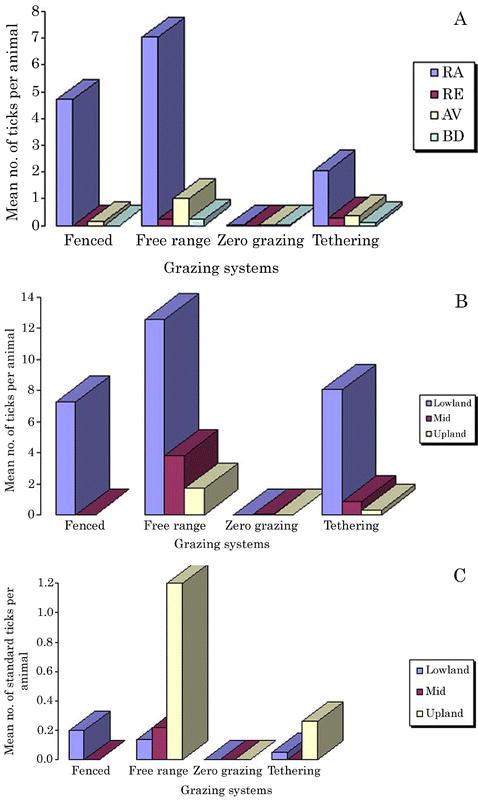
Tick challenge in different grazing systems and agro-ecological zones, Mbale District. A) The challenge of individual tick species, Rhipicephalus appendiculatus (RA), R. evertsi (RE), Amblyoma varigetum (AV), Boophilus decoloratus (BD). B) Mean challenge of all tick species in different zones and grazing systems. C) Mean number of standard ticks under different grazing systems in three zones.
The odds of the animals being infested with R. appendiculatus were approximately 1.3 times (lowland fenced), 183 times (lowland free range) and 365 times (lowland tethering) greater than in animals kept in the upland zone under zero-grazing system (Table 1). The animals within the age groups 0 – 3 and 4 – 12 months were at less risk of being infested with R. appendiculatus than the older groups (> 18 months).
Table 1.
The odds ratio for infestation with R. appendiculatus, at 95% confidence intervals (CI).
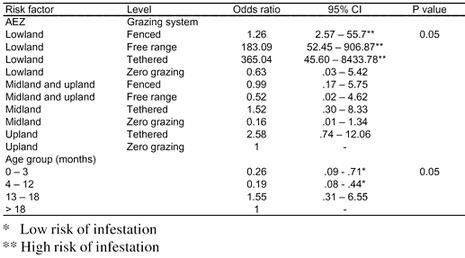
As for B. decoloratus, the animals kept in the lowland (free range grazing system) and midland (tethered and zero-grazing systems) were at less risk of being infested than the animals in the upland zone under zero-grazing system (Table 2). As expected, calves (0–3 months old) were at a less risk of being infested with B. decoloratus than the older groups (>18 months).
Table 2.
The odds ratio for infestation with B. decoloratus, at 95% confidence intervals (CI).
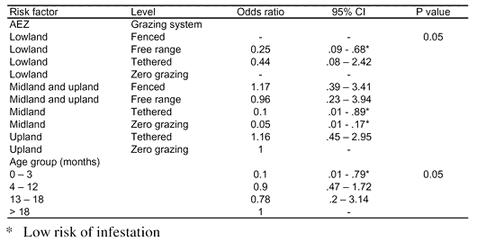
Tick control
The farmers who practiced fenced and zero-grazing systems had better knowledge of the problems caused by ticks and tick-borne diseases than those who practiced tethering and free range grazing systems. Ticks and tick-borne diseases were controlled using acaricides belonging to the groups of organophosphates (OPs), amidines and synthetic pyrethroids. These acaricides were used indiscriminately in all the grazing systems. However, they were used at different intensities, depending on the zone and grazing system. Synthetic pyrethroids were popular in the fenced and zero-grazing systems, while amidines were equally used in the free-range, zero-grazing and tethering systems (Figure 2). OPs were popular in the free range and zero grazing systems. The commonest methods of acaricide application were hand-dressing, hand-spraying and pour-on; and the extent of their use varied in the different grazing systems. Some farmers in the free-range, zero-grazing and tethering grazing systems did not practice tick control (Figure 2).
Figure 2.

Variations in the types of acaricides used in the different grazing systems.
Prevalence of serum antibodies to tick-borne infections
The prevalence of antibody to tick-borne infections differed across the grazing systems, age of animals and zones. In animals 4–12 months old, the serum antibody prevalence for T. parva was > 60% in the free-range cattle in the lowland zone (Figure 3). Except for tethered cattle under the midland zone, the prevalence of antibodies to T. parva was below 50% in the midland and upland zones.
Figure 3.
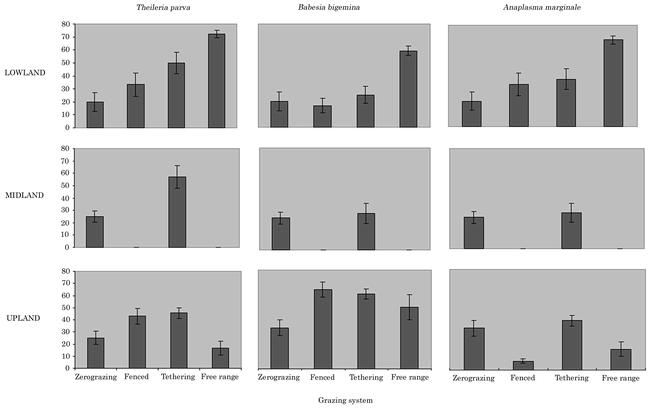
Mean serum antibody prevalence to tick-borne diseases in age bracket 4–12 months, in different grazing systems and agro-ecological zones. Error bars denote the standard error of the prevalence (%).
The prevalence of antibodies to B. bigemina and A. marginale in the 4–12 month age group varied greatly across the zones and grazing systems. B. bigemina, antibody levels above 60% occurred only in the lowland (free range grazing system) and upland (fenced and tethering grazing system). Animals older than 12 months under free range (lowland zone), or fenced and tethering grazing systems (upland zone), also had a high prevalence of antibodies against B. bigemina. In cattle 4–12 months old, A. marginale, antibody levels above 60% were recorded only in the lowland zone under the free range grazing system. The sero-prevalence of antibodies to T. parva was associated (p < 0.05) with zone, age and grazing system. Compared to animals kept in the upland zerograzing system, the odds of being exposed to Theileria parva infection were 7.8 times greater in the lowland free-range system and 4.0 times greater in the lowland tethering grazing system (Table 3).
Table 3.
The odds ratio for infection with T. parva, at 95% confidence intervals (CI).
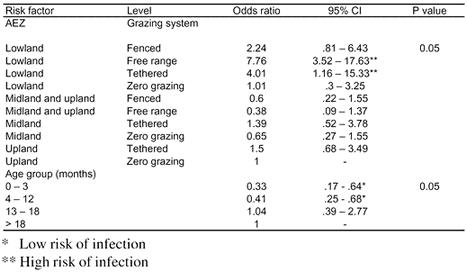
The situation in the case of A. marginale and B. bigemina was different from that of T. parva (Tables 4 and 5). In the case of A. marginale, there was a significant association (p < 0.05) between sero-prevalence and both age and zone. The prevalence decreased with increasing elevation in the case of the fenced and free-range systems (Figure 3). As for antibodies to B. bigemina, there was an association (p < 0.05) between sero-prevalence and zone. Animals (4–12 months old) in the upland zone had higher sero-prevalence for B. bigemina (Figure 3). The prevalence of antibodies to B. bigemina was also associated with age and grazing system (p < 0.05).
Table 4.
The odds ratio for infection with A. marginale, at 95% confidence intervals (CI).
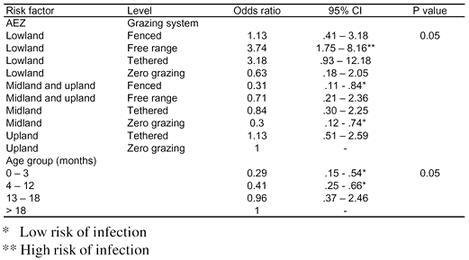
Table 5.
The odds ratio for infection with B. bigemina, at 95% confidence intervals (CI).
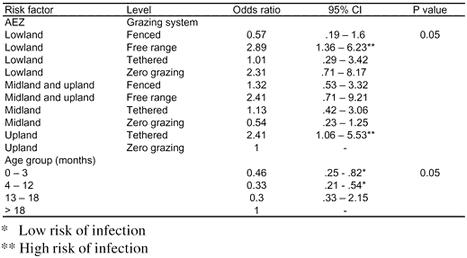
Discussion
The present study provided an opportunity to understand the farm circumstances and farm practices that have a bearing on the occurrence of ticks and tick-borne diseases in smallholder dairy farms in Mbale District. This logical approach has been adopted earlier by Gitau et al. (1997, 2000).
The highest tick challenge was recorded in the lowland zone, followed by midland and upland zones. This concurs with the results from Kenya highlands reported by Gitau et al. (1997). These results can be explained by the distribution of the ticks and farming practices in these strata. Climatically, the lowlands are more suitable for R. appendiculatus than the midlands and uplands (Mathysse and Colbo 1987). Also, in the lowlands most of the animals were the local indigenous breeds kept under the free-range grazing system, a system that is known to increase the spread of ticks among cattle herds. Many farmers in this zone reported not having practiced tick control.
Low tick challenge was demonstrated in all zero grazing strata including the lowland zone because in zero grazing systems tick challenge is almost exclusively through the importation of ticks on fodder from neighboring farms, roadsides and/ or swamps and fodder banks. Since there is little habitat on zero-grazing farms to support tick populations, the tick challenge on such farms is very low. Transmission of infection by ticks to cattle was, therefore, very low; hence the low prevalence of serum antibodies to tick-borne pathogens in all farms that practiced zero-grazing irrespective of the zone.
The odds ratios for R. appendiculatus infestation in respect of lowland free range (183) and lowland tethered (365) appear very large and probably unrealistic, as are the respective confidence intervals (53-907 and 46-8434). This is explained by the low numbers of animals with R. appendiculatus on them in the upland zero grazing system, which we used as the reference group. On the contrary most of the animals in the lowland grazing system had R. appendiculatus, hence the observed high odds ratios for these grazing systems.
The highest number of standard ticks were recorded in the upland zone and these ticks were mainly Boophilus species because at this elevation (600–2,300 meters above sea level), this tick is most abundant (Matthysse and Colbo, 1987). Another reason is that farmers in the upland zone tended not to worry about their animals being infested with ticks since East Coast Fever, a well known tick-borne killer disease, was not a threat here. The tick vector, R. appendiculatus is very rare at these elevations (Matthysse and Colbo, 1987). The farmers were therefore lax in their tick control regimes or did nothing to control the ticks. Thus, ticks were allowed to feed to engorgement and hence the common finding of standard ticks in the upland zone. Standard ticks are ticks that have fed successfully and would engorge and detach in the following 24 hours (Kaiser et al. 1982). This was possible because either the animals were naïve to tick infestation and were, therefore, highly susceptible or because the ticks were not removed by any means by the farmer.
The detection of antibodies to all of the tick-borne disease pathogens in calves as young as 0–3 months was expected since, at this age, passively transferred colostral antibodies are still in high titer in the serum of the animals (Burrdge and Kimber 1973). In this study, a special effort was made to scrutinize the sero-prevalence of antibodies to tick-borne diseases pathogens in older calves, 4–12 months old. This was done because it is known that by the age of 2–4 months, the passively transferred colostral antibodies have waned to undetectable levels (Burridge and Kimber, 1973). It was assumed that the antibodies detected in this age group (4–12 months) were due to infection from infected ticks and so indicated exposure to tick infection.
There was variability in serum antibody prevalence to the three tick-borne diseases and the degree of tick infestation across the zones, grazing systems and age of animals. Tick control standards also varied with zones and grazing systems. Consideration of a combination of these facts suggests existence of different epidemiological states for the three diseases in the district. These findings suggest that endemic stability to the three tick-borne diseases (East Coast Fever, babesiosis and anaplasmosis) most likely exists in the lowland zone, particularly, under the tethering and free-range grazing systems where sero-prevalence to tick-borne diseases pathogens and tick challenge was highest. An endemically stable state is characterized, among other things, by high antibody prevalence (>70%) and a constant tick challenge, while endemic instability is characterized by low antibody prevalence of <30% (Norval et al.1992, Deem et al. 1993, Perry and Young 1995). Animals in the midland and upland zones were in an endemically unstable state (for East Coast Fever) because R. appendiculatus challenge here was low because of the sub-optimal climatic conditions for this tick at these elevations. Seroprevalence of antibodies to B. bigemina (>60%) and a high B. decoloratus tick challenge was found in animals (4–12 months old) in the upland zones, also suggesting that endemic stability to babesiosis most likely exists in the upland zones. This explains the laxity in tick control measures instituted at the high elevations as a sizable number of farmers were not perturbed by B. decoloratus infestation of their animals. This difference in epidemiological states of East Coast Fever across zones and grazing system has been reported previously (Gitau et al. 1997) in the Kenyan highlands.
Our findings underscore the importance of structured observational studies in guiding the planning of ticks and tick-borne diseases control strategies since control strategies should be tailored to different production systems and cattle population at high risk of the diseases. This is better done after the factors associated with acquisition of infection; infection patterns and the production losses associated with these infections have been established through a longitudinal study. This is our next study in the same district.
Acknowledgments
We acknowledge the support provided by the District Veterinary Officer, Mbale and his technical staff. We thank Messrs; G. Odyek and Musoke of LIRI and Faculty of Veterinary Medicine, Makerere University, respectively, for their technical assistance. The cooperation of the small holder farmers in offering their valuable time and their animals for sampling is highly appreciated. This study was conducted with the support of the Livestock System Research Project (LSRP) supported by DANIDA's Agriculture Sector Programme Support (ASPS) to Uganda to whom we are very grateful. We would like to thank the Dean Faculty of Veterinary Medicine, Makerere University and the Director General National Agricultural Research Organisation (NARO) for permission to have this paper published.
References
- Amir , Knipscher . Conducting on farm animal research. Winrock International. 1989;2:23–27. [Google Scholar]
- Bram RA. 1983 Tick-borne livestock diseases and their vectors: The global problem. In: Ticks and tick-borne diseases, FAO Animal Production and Health Paper No. 36. Food and Agriculture Organization, Rome, pp. 7–11. [Google Scholar]
- Branagan D. Observations on the development and survival of the ixodid ticks Rhipicephalus appendiculatus (Neumann 1901) under quasi natural conditions in Kenya. Tropical Animal Health and Production. 1973;5:153–165. doi: 10.1007/BF02251384. [DOI] [PubMed] [Google Scholar]
- Burridge MJ, Kimber CD. Studies on colostral antibodies to Theileria parva using the indirect fluorescent antibody test. Zeitschrift Fur Tropenmedizin Und Parasitologie. 1973;24:305–310. [PubMed] [Google Scholar]
- Deem SL, Perry BD, Katende JM, McDermott JJ, Mahan SM, Maloo SH, Morzaria SP, Musoke A.J, Rowlands GJ. Variations in prevalence of tick-borne diseases in Zebu cattle by agroecological zone: implications for East Coast fever immunisation. Preventive Veterinary Medicine. 1993;16:171–187. [Google Scholar]
- Gitau GK, Mcdermott JJ, Waltner-Toews D, Lissemore KD, Osumo JM, Muriuki D. Factors influencing calf morbidity and mortality in smallholder dairy farms in Kiambu District of Kenya. Preventive Veterinary Medicine. 1994;21:167–177. [Google Scholar]
- Gitau GK, Perry BD, Katende JM, McDermott JJ, Morzaria SP, Young AS. The prevalence of serum antibodies to tick-borne infections in cattle in smallholder dairy farms in Murang'a District, Kenya; a cross-sectional study. Preventive Veterinary Medicine. 1997;30:95–107. doi: 10.1016/s0167-5877(96)01100-2. [DOI] [PubMed] [Google Scholar]
- Gitau GK, Perry BD, McDermott JJ. The incidence, morbidity and mortality due to Theileria parva infections in smallholder dairy farms in Murang'a District, Kenya. Preventive Veterinary Medicine. 2000;39:65–79. doi: 10.1016/s0167-5877(98)00137-8. [DOI] [PubMed] [Google Scholar]
- Kaise MN, Sutherst RW, Bourne AS. Relationship between ticks and zebu cattle in southern Uganda. Tropical Animal Health and Production. 1982;14:63–74. doi: 10.1007/BF02282583. [DOI] [PubMed] [Google Scholar]
- Katende JM, Toye P, Skilton RA, Nene V, Morzaria SP, Musoke AJ. An ELISA for detection of Theileria parva antibodies in cattle using a recombinant polymorphic immunodominant molecule. Parasitology Research. 1998;84:408–416. doi: 10.1007/s004360050419. [DOI] [PubMed] [Google Scholar]
- Martin SW, Meek AH, and Willeberg P. 1987 Veterinary Epidemiology. Principles and Methods. Iowa State University Press, Ames. [Google Scholar]
- Matthysse JG, Colbo MH. 1987 The Ixodid Ticks of Uganda. Ecological Society of America. College Park, Maryland. pp. 426. [Google Scholar]
- Maywald GF, Sutherst RW. 1987 Ecological models. 1. Assessingclimatic favourability with CLIEX. In: Ticks and Tick-borne diseases. Proceedings of an international Workshop on the ecology of ticks and epidemiology of tick-borne diseases. Nyanga Zimbabwe, 17–21, 1986. [Google Scholar]
- NARO/Livestock System Research Programme (LSRP) Report. Ministry of Agriculture Animal Industry and Fisheries, Entebbe, Uganda 1999 [Google Scholar]
- Nicholson M.J, Butterworth M.H. 1986 A guide to condition scoring of zebu cattle. International Livestock Livestock Institute for Africa. 29. pp. [Google Scholar]
- Norval RAI, Perry BD, and Young AS. 1992 The Epidemiology of Theileriosis in Africa. Academic Press Ltd. London. [Google Scholar]
- O'Callaghan CJ. 1998 A study of the epidemiology of theileriosis on smallholder dairy Farms in Kiambu District, Kenya. PhD thesis, University of Guelph. [Google Scholar]
- Okello-Onen J, Tukahirwa EM, Ssenyonga GSZ, Perry BD, Katende JM, Musisi G, and Mwayi MT. 1994 Epidemiology of Theileria parva under ranch conditions in Uganda. In: Rowlands GJ, Kyule MN and Perry BD editors. Proceedings of the 7th International Symposium on Veterinary Epidemiology and Economics, Nairobi, 15–19 August. The Kenyan Veterinarian. (Special Issue). 18(2):362–365. [Google Scholar]
- Pegram RG, Chizyuka HGB. 1987 Towards an assessment of the economic impact of ticks on rural development. ACIAR Proceedings. 17:104–107.Canberra Australia. [Google Scholar]
- Perry BD. The role of epidemiology and economics in the control of tick-borne diseases of livestock in Africa. The Kenyan Veterinarian. 1994;18(2):7–10. [Google Scholar]
- Perry BD, Grandin BE, Mukhebi AW, Young AS, Chabari F, Maloo S, Thorpe W, Delehanty J, Mutugi JJ, and Murethi J. 1990 Techniques to identify target populations for immunization and to assess the impact of controlling East Coast Fever in Kenya. Young AS, Mutugi J.J. and. Maritin A.C editors. KARI. [Google Scholar]
- Perry BD, Young AS. The past and future roles of epidemiology and economics in the control of tick-borne diseases of livestock in Africa: the case of theileriosis. Preventive Veterinary Medicine. 1995;25:107–120. [Google Scholar]
- Perry BD, Randolph TF. Improving the assessment of the economic impact of parasitic diseases and of their control in production animals. Veterinary Parasitology. 1999;84:145–168. doi: 10.1016/s0304-4017(99)00040-0. [DOI] [PubMed] [Google Scholar]
- SAS Institute Inc. 1999 SAS/STAT User's Guide, Version 8, 4th Edition. SAS Institute. [Google Scholar]
- Woo PTK. The haematocrit centrifugation technique for the diagnosis of African trypanosomiasis. Acta Tropica. 1970;27:384–386. [PubMed] [Google Scholar]
- Wright P.F, Nelson F, Van Rooij E.M.A, Lelenta M, Jeggo MH. Standardisation and validation of enzyme-linked immunisorbent assay techniques for the detection of antibody in infectious disease diagnosis. Revue Scientific Technique Office Internationale Epizootique. 1993;12:435–450. doi: 10.20506/rst.12.2.691. [DOI] [PubMed] [Google Scholar]
- Yeoman GH. Field vector studies of epizootic East Coast Fever. I. A quantitative relationship between Rhipicephalus appendiculatus and the epizooticity of East Coast Fever. Bulletin of Epizootic Diseases of Africa. 1966;14(5):15–27. [PubMed] [Google Scholar]


